Virtual assistant payment methods
Virtual assistants can receive payment by invoice, direct payment, direct debit, cheque or bank transfer.
When running a virtual assistant business, you will send invoices and perhaps take direct payments from your customers. This guide will help you understand the options and processes involved with invoicing and billing your virtual assistant clients.
The first thing you should do if you haven’t already is separate your personal finances from your business. Using a separate bank account for business and personal use will help reconcile your accounts and prevent you from spending business funds for personal use.
You will need to have already determined how much you will be charging for your services. You can find more information about what you should be charging and how to determine your rates as a virtual assistant here.
I also recommend that you use a time tracking software such as Toggl. This helps you keep track of how long you spent doing each task. This information can be sent to your client to make them aware that their money is being well spent.
When should you bill or charge your client?
Different virtual assistants go about this in different ways. Sometimes it may take a bit of trial and error to work out the best option for you. Use the information below to determine when you should charge your client.
Full amount upfront
Charging the total amount upfront will ensure that there are no delays when it comes to receiving payment. It also ensures that you don’t forget to invoice your client.
Take into account some clients may not be in the position to pay you the total amount upfront. You may risk alienating some of your audience as they may not be in the position to pay upfront, this is likely to be the case when your client is a startup business.
You may be better off choosing this option if you already built a trusted relationship with your audience and you already have an established customer base.
This option may be harder for new virtual assistants who have not built a reputation with their audience because the customer needs time to build trust.
Half or another % upfront – The rest upon completion
If you charge your customer half upfront and then the other half upon completion, this minimises risk. Depending on the type of customer, this option may suit them better as many service-based businesses rely on their income at the end of the month to pay you.
This option is perfect for new virtual assistants. This will help you build trust with your client and help your client build trust with you.
Your client has to trust that you will begin and complete the work when they pay you the first half.
You, in return, also have to trust the client that they will pay you the rest after you have completed the task.
This is usually the safest option for both parties involved hence why this is usually the most popular option.
Full amount upon completion
As a virtual assistant myself, I personally do not recommend this option.
However, there may be a few occasions or a few ‘elite’ clients that you may want to bend the rules for.
This will usually be because you have a certain amount of trust in that company and know they have more than enough money to pay you.
For example, you have landed some virtual assistant work with a big corporation, and you know they have the ability to pay you. In this case, you may want to change your invoicing terms and conditions for this customer.
The thing to bear in mind is that even if you know they will pay you, can you guarantee they will pay you on time?
If you are working with a new client, you may want to send them an invoice early. I usually invoice new clients two weeks in advance.
I give them a heads up about this beforehand, I do this in case there are any late payers this way they have two weeks early notice, so they shouldn’t be surprised and will be prepared when the invoice is due.
When and how should you bill your virtual assistant client?
There is no right or wrong answer. It is always safest to get some money upfront especially if you do not know the client well. To avoid any issues, no matter how well you know the client, getting some payment upfront is still recommended. In the event that the client doesn’t pay once the work is done, at least it would be half the amount outstanding rather than the whole amount.
Which method should I use to charge or bill virtual assistant clients?
Invoicing – The most popular for virtual assistants and other similar freelance services.
Direct payment – This could be via Paypal, Stripe or another online payment processor.
Direct Debit – A convenient way to set up recurring payments for a service.
Bank Transfer – You can save money on card processing fees by offering this as an option.
Invoicing Software
While you can still use a spreadsheet to create an invoice, many invoicing software options are available to make the process easier for you. They help to manage invoicing so that you know when a payment is due or overdue.
They also send reminders for non-payment to help you manage your accounts.
This makes it easier when it comes time to do your tax return. Usually, all of your data can just be downloaded into your accounts.
One of the most popular invoicing software choices on the market right now is Freshbooks. They offer a free trial to help you get used to it. They also have a time tracking feature, so when you finish tracking the time on a project, you just push a button, and the customer receives an invoice.
The invoicing software that I use is VCita. It is more than an invoicing software, it is also a lead generation software app and much more. VCita is the number 1 app I use to manage Prime PA. I highly recommend it for many reasons, which you can learn about here.
Another option that is very popular and that you may already be familiar with is Paypal. They also have invoicing software that you can use to charge your clients.

What an invoice should include
- Your company name, address, website and phone number.
- If you’re a Limited company – include your company number.
- If you are VAT registered – include those details.
- Your client’s details – name, company name, address and email.
- The invoice number – Make sure this is unique every time.
- The date of the invoice – When it is being sent
- The payment due date – This should be clearly stated in your contract terms.
- The amount due – Ensure the customer is aware of the currency you’re using to bill them.
- The service(s) provided. Outline the tasks undertaken, the duration, the date(s) the work was carried out, and your rate.
- How your client can make payment – provide your bank details, PayPal details or link to your payment processor.
Providing all this information on the invoice lets the client see the full breakdown, so they know exactly what they are paying for.
NOTE: This may seem obvious but ensure the word ‘Invoice’ is clearly displayed on the invoice.
Direct Payment Software
You may just want to receive a payment for something without having to send an invoice. You may have retainer packages that people can just order and pay for on your website. Or you may just take direct payment upfront or have a store. Whatever your reasons, you can use a direct payment option in your business.
Whether you are setting up direct payment or invoicing, you will still need an online payment processor to accept the funds.
Paypal and Stripe are the most popular. They both have fees associated with them, this depends on how much money you receive.
Bank Transfer Set-up
To receive payments by bank transfer is easy, you just need to give your clients your bank details. Some people like to offer this as an option; however, some virtual assistants do not market this as an option but will notify their clients that the option is available. Payment processing fees can add up to a lot over time, enabling you to make a saving by choosing to be paid by bank transfer.
This option allows you to charge less than you probably would if you are using an online payment processor because you do not have to take into account any fees and markup prices when determining your rates.
Direct Debit
Direct debit could be a convenient option for you to offer to clients on retainer packages. Direct Debit is a trusted option for many customers due to the direct debit guarantee that comes with this option. GoCardless allows you to easily set up direct debit as an option to receive payment for your services. They charge a fee per transaction, which can be used for one-off or variable amounts on a recurring basis.

Learning to identify problematic customers will help you to avoid doing work and not getting paid for it.
This is usually more prone to happen when you first start in business, however this can happen anytime. If you ever feel awkward about a client or something just doesn’t feel right, then make sure to take the whole amount of money upfront or don’t deliver the project fully until full payment has been received. Whatever you decide to do, your customer needs to agree to this before any work begins. This way you will avoid any disagreements when it comes to receiving payment.
On the Downloads page you can find templates to help avoid late payment.
VA Business Management Course


![]()


